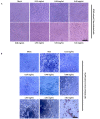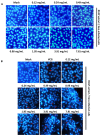In vitro Antiviral Activity of Rubia cordifolia Aerial Part Extract against Rotavirus
- PMID: 27679574
- PMCID: PMC5020101
- DOI: 10.3389/fphar.2016.00308
In vitro Antiviral Activity of Rubia cordifolia Aerial Part Extract against Rotavirus
Abstract
The root of Rubia cordifolia has been used traditionally as a hemostatic agent, while the aerial part of the plant consisting of leaf and stem is known to exhibit anti-diarrheal properties and has been widely used as a remedy in many parts of China. As rotavirus is one of the most commonly associated diarrhea-causing pathogen, this study aims to investigate the anti-rotaviral effect of R. cordifolia aerial part (RCAP). The cytotoxicity of RCAP toward MA-104 cells was evaluated using the WST-8 assay. Colloidal gold method and real time polymerase chain reaction (qPCR) assay were used to confirm the findings of the antiviral assay. Then, 4',6-diamidino-2-phenylindole (DAPI) staining method was subsequently used to investigate the mode of death among the cells. And the representative components of aqueous extract were isolated and identified. It was shown that both the viability of MA-104 cells and the viral load were reduced with increasing concentration of the extract. DAPI staining showed that virus-induced apoptosis was the cause of the low cell viability and viral load, an effect which was accelerated with incubation in the aqueous herbal extract. The major compounds postulated to exhibit this activity were isolated from the aqueous herbal extract and identified to be compounds Xanthopurpurin and Vanillic Acid. This study showed that RCAP extract effectively inhibited rotavirus multiplication by promoting virus-induced apoptosis in MA-104 cells.
Keywords: Rubia cordifolia; aerial part; antiviral activity; apoptosis; diarrhea; rotavirus.
Figures






Similar articles
-
Anti-diarrheal and anti-inflammatory activities of aqueous extract of the aerial part of Rubia cordifolia.BMC Complement Altern Med. 2017 Jan 5;17(1):20. doi: 10.1186/s12906-016-1527-9. BMC Complement Altern Med. 2017. PMID: 28056930 Free PMC article.
-
Anti-thrombotic and pro-angiogenic effects of Rubia cordifolia extract in zebrafish.J Ethnopharmacol. 2018 Jun 12;219:152-160. doi: 10.1016/j.jep.2017.11.005. Epub 2017 Nov 7. J Ethnopharmacol. 2018. PMID: 29126989
-
Antiviral activity of hydroalcoholic extract from Eupatorium perfoliatum L. against the attachment of influenza A virus.J Ethnopharmacol. 2016 Jul 21;188:144-52. doi: 10.1016/j.jep.2016.05.016. Epub 2016 May 10. J Ethnopharmacol. 2016. PMID: 27178637
-
Amelioration of cisplatin induced nephrotoxicity in Swiss albino mice by Rubia cordifolia extract.J Cancer Res Ther. 2008 Jul-Sep;4(3):111-5. doi: 10.4103/0973-1482.43139. J Cancer Res Ther. 2008. PMID: 18923202
-
Evaluation of analgesic and anti-inflammatory activities of Rubia cordifolia L. by spectrum-effect relationships.J Chromatogr B Analyt Technol Biomed Life Sci. 2018 Jul 15;1090:73-80. doi: 10.1016/j.jchromb.2018.05.021. Epub 2018 May 17. J Chromatogr B Analyt Technol Biomed Life Sci. 2018. PMID: 29793098 Review.
Cited by
-
Rubia cordifolia L. ameliorates DSS-induced ulcerative colitis in mice through dual inhibition of NLRP3 inflammasome and IL-6/JAK2/STAT3 pathways.Heliyon. 2022 Aug 19;8(8):e10314. doi: 10.1016/j.heliyon.2022.e10314. eCollection 2022 Aug. Heliyon. 2022. PMID: 36082330 Free PMC article.
-
Ammi-visnaga extract; a novel phyto-antiviral agent against bovine rotavirus.Virusdisease. 2023 Mar;34(1):76-87. doi: 10.1007/s13337-022-00803-w. Epub 2023 Jan 4. Virusdisease. 2023. PMID: 37009254 Free PMC article.
-
Immunomodulatory Efficacy-Mediated Anti-HCV and Anti-HBV Potential of Kefir Grains; Unveiling the In Vitro Antibacterial, Antifungal, and Wound Healing Activities.Molecules. 2022 Mar 21;27(6):2016. doi: 10.3390/molecules27062016. Molecules. 2022. PMID: 35335377 Free PMC article.
-
Antiviral Activity Against Infectious Bronchitis Virus and Bioactive Components of Hypericum perforatum L.Front Pharmacol. 2019 Oct 29;10:1272. doi: 10.3389/fphar.2019.01272. eCollection 2019. Front Pharmacol. 2019. PMID: 31736754 Free PMC article.
-
Metabolomic profile of medicinal plants with anti-RVFV activity.Heliyon. 2022 Feb 12;8(2):e08936. doi: 10.1016/j.heliyon.2022.e08936. eCollection 2022 Feb. Heliyon. 2022. PMID: 35243061 Free PMC article.
References
LinkOut - more resources
Full Text Sources
Other Literature Sources
Research Materials

